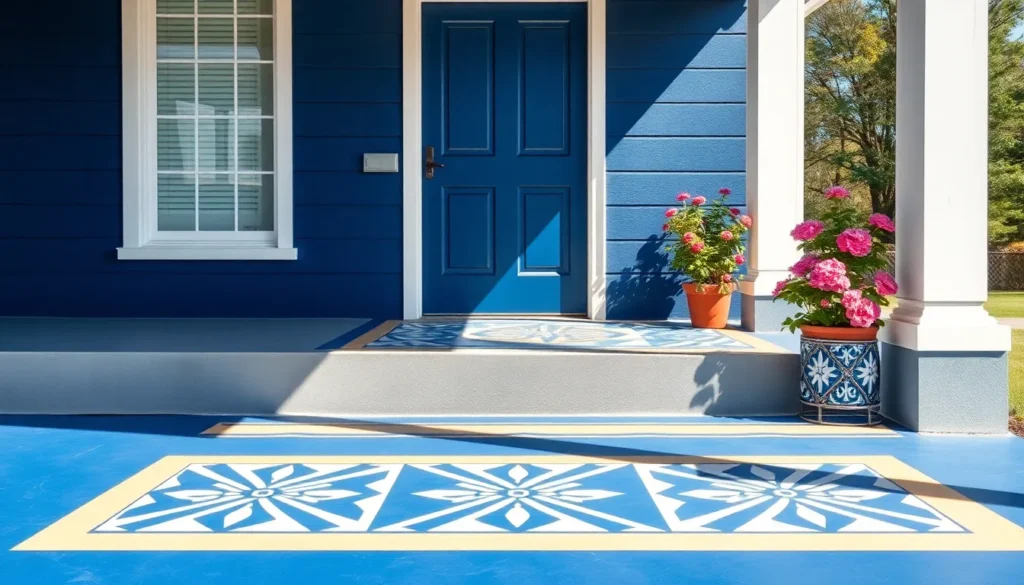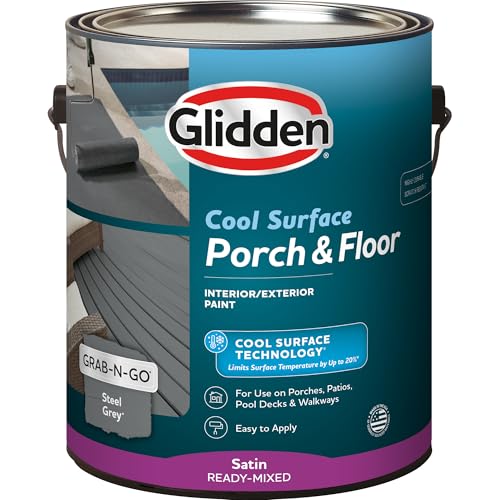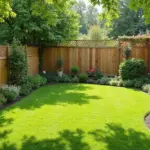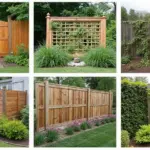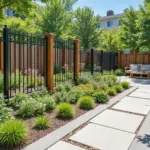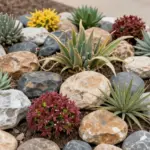Your concrete porch doesn’t have to be a boring gray slab that visitors barely notice. With the right paint ideas and techniques, we can transform this essential outdoor space into a stunning focal point that welcomes guests and adds serious curb appeal to your home.
We’ve discovered that concrete porch painting isn’t just about slapping on any old color and calling it done. The best results come from understanding which paints work best on concrete surfaces, how different colors affect your home’s overall aesthetic, and what creative techniques can make your porch stand out from every other house on the block.
Whether you’re dreaming of a classic solid color that complements your home’s architecture or you’re ready to explore bold patterns and decorative finishes, we’ll show you exactly how to achieve professional-looking results. From prep work to final touches, these paint ideas will help you create a porch that’s both beautiful and built to last through seasons of foot traffic and weather.
Choose the Right Concrete Porch Paint for Your Project
Selecting the perfect paint type determines both the appearance and longevity of your concrete porch project. We’ll explore three primary paint options that deliver exceptional results for different needs and situations.
Acrylic Latex Paint for Durability
Acrylic latex paint stands as our top recommendation for most concrete porch painting projects due to its outstanding weather resistance and flexibility. This paint type expands and contracts with temperature changes, preventing cracks and peeling that commonly affect other paint formulations. We find that high-quality acrylic latex paints can last 7-10 years on concrete surfaces when properly applied.
Benefits include excellent UV protection, easy cleanup with soap and water, and quick drying times of 2-4 hours between coats. Popular brands like Sherwin-Williams ConcreteWorks and Behr Premium offer specialized acrylic formulas designed specifically for concrete surfaces. These paints resist moisture penetration while allowing the concrete to breathe naturally.
Application becomes straightforward with standard brushes and rollers, making this option ideal for DIY enthusiasts. We recommend choosing semi-gloss or satin finishes for porches since they provide better dirt resistance and easier maintenance than flat finishes.
Epoxy Paint for High-Traffic Areas
Epoxy paint delivers unmatched durability for concrete porches that experience heavy foot traffic or harsh weather conditions. This two-part coating system creates an extremely hard, chemical-resistant surface that can withstand decades of use without showing important wear.
Installation requires more preparation time since epoxy bonds best to etched or mechanically abraded concrete surfaces. We suggest using muriatic acid etching or diamond grinding to create the proper surface profile before application. The curing process takes 24-72 hours, during which the porch remains unusable.
Performance characteristics include superior abrasion resistance, complete waterproofing, and the ability to handle temperature extremes from -40°F to 140°F. Rust-Oleum EpoxyShield and Sherwin-Williams Armorseal are proven products that consistently deliver professional-grade results. Colors remain vibrant for 15-20 years, making this investment worthwhile for high-value properties.
Maintenance involves simple sweeping and occasional mopping with mild detergent, as the non-porous surface prevents stains from penetrating.
Concrete Stain for Natural-Looking Results
Concrete stain penetrates deep into the porous surface, creating rich, translucent colors that enhance rather than hide the natural texture of concrete. We use acid-based stains for permanent, fade-resistant results or water-based stains for more color control and easier application.
Acid stains react chemically with the concrete’s lime content, producing unique marbled effects and earth-tone colors like terracotta, sage green, and warm browns. Each application creates one-of-a-kind patterns since the chemical reaction varies based on the concrete’s composition and age. Brands like Kemiko Stone Tone and SureCrete ColorFast offer reliable acid stain systems.
Water-based stains provide broader color options including blues, reds, and purples while maintaining the concrete’s natural appearance. These products dry faster and produce less odor during application, making them suitable for enclosed porches or areas with limited ventilation.
Protection requires applying a clear sealer coat after staining to prevent wear and enhance color depth. We recommend resealing every 3-5 years to maintain optimal appearance and protection.
Prepare Your Concrete Porch for Painting Success
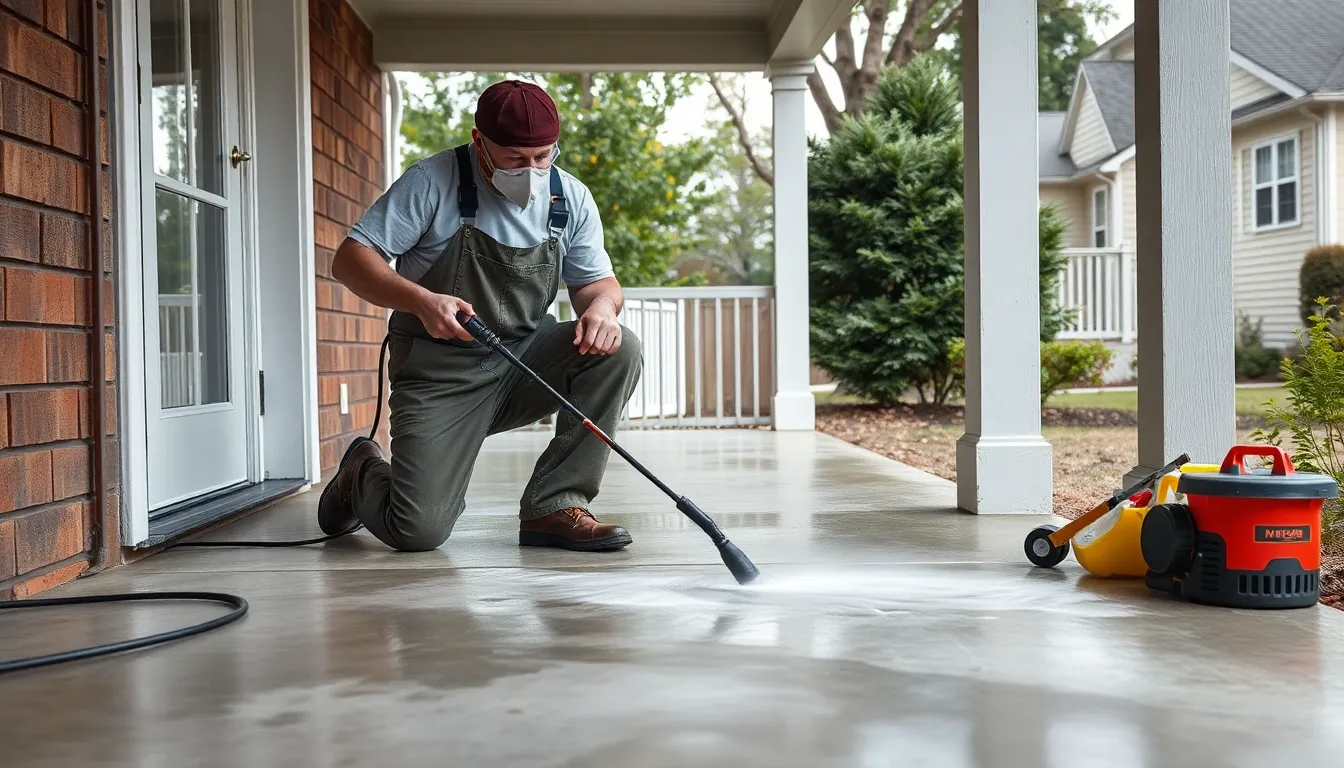
Proper preparation forms the foundation of any successful concrete porch painting project. We’ll walk you through the essential steps that ensure your paint adheres properly and lasts for years to come.
Clean and Degrease the Surface
Start by thoroughly cleaning your concrete porch to remove all dirt, dust, grease, and old paint residues that could prevent proper paint adhesion. We recommend using a pressure washer for the most effective cleaning, though you can also scrub with a concrete cleaner if pressure washing isn’t available.
Focus on removing every trace of contamination since cleaning is crucial for both paint adhesion and longevity. Grease stains require special attention, so apply a degreasing solution to these areas and scrub vigorously before rinsing. Allow the surface to dry completely before moving to the next preparation step, as moisture trapped beneath paint will cause premature failure.
Repair Cracks and Imperfections
Inspect your porch carefully for cracks, holes, and surface defects that could compromise your paint job’s appearance and durability. Small cracks might seem insignificant, but they’ll allow water infiltration that leads to paint failure over time.
Use fast setting hydraulic cement for larger repairs and ready to use acrylic fillers like DRYLOK® Fast Plug or Masonry Crack Filler for smaller cracks and holes. Fill each imperfection completely, ensuring the repair material sits slightly above the surrounding surface. Sand or smooth out any raised patches after the filler cures to create a flat, even surface that’ll accept paint uniformly.
Check for loose or flaking concrete around the repair areas and remove any unstable material before applying fillers. This step prevents future paint problems and ensures your repairs blend seamlessly with the existing concrete.
Apply Primer for Better Adhesion
Choose a concrete and masonry exact primer designed for outdoor floors rather than standard wall primers. These specialized primers create the chemical bond between concrete and paint that ensures long lasting results.
Apply the primer evenly with a roller using smooth, overlapping strokes while reaching edges and corners with a brush for complete coverage. Most concrete primers require 12 to 24 hours drying time, though some products may need longer curing periods depending on temperature and humidity conditions.
Consider applying a second coat of primer for optimal results, especially on porous or previously unpainted concrete surfaces. We’ve found that this extra step significantly improves paint adhesion and coverage, making it easier to achieve the professional looking finish you want for your concrete porch painting project.
Create a Classic Solid Color Look
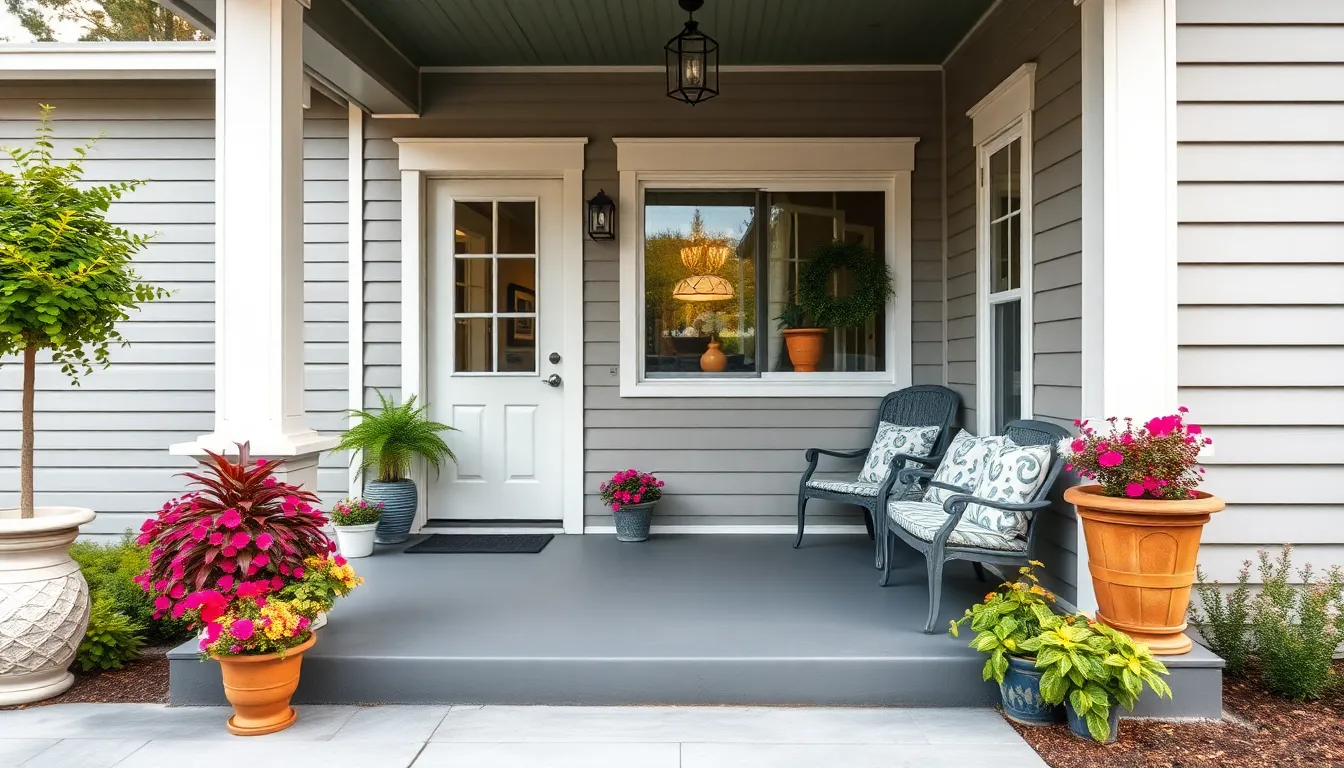
Classic solid colors offer the most straightforward approach to concrete porch painting while delivering stunning results. We’ve identified three standout options that consistently transform ordinary concrete into beautiful outdoor spaces.
Neutral Gray for Timeless Appeal
Gray concrete porch paint creates a versatile foundation that complements various architectural styles without overwhelming your home’s exterior design. This timeless color choice coordinates seamlessly with surrounding industry elements and existing exterior colors, making it our top recommendation for homeowners seeking long term appeal.
Neutral gray tones enhance the natural texture of concrete surfaces while providing a sophisticated backdrop for outdoor furniture and decorative elements. We particularly appreciate how gray paint allows architectural details to shine while creating visual cohesion between your porch and home’s overall aesthetic.
Subtle pattern additions like checkerboards or stripes in complementary gray shades can add dimension to your porch surface without sacrificing the classic elegance that makes gray such a popular choice. These decorative touches work especially well on larger porch areas where solid color might feel too plain.
Crisp White for Clean Elegance
White concrete paint delivers fresh, clean elegance that instantly brightens your porch space and enhances curb appeal through its light reflecting properties. We recommend using high quality porch and patio floor enamel paint like Sherwin Williams’ “Snowbound” to ensure durability and achieve that smooth, professional finish you’re looking for.
Clean white surfaces create an inviting atmosphere that pairs beautifully with any house color, making this option incredibly versatile for different home styles. This classic choice works particularly well on covered porches where the white paint won’t face constant direct sunlight exposure.
White paint also provides the perfect canvas for seasonal decorations and outdoor furniture arrangements, allowing your personal style to take center stage. We’ve found that white concrete porches photograph beautifully and significantly boost a home’s visual appeal from the street.
Bold Navy for Modern Sophistication
Navy concrete porch paint offers modern sophistication that makes a strong visual statement while maintaining classic appeal. This rich color adds depth and character to your outdoor space, working especially well when paired with lighter colored siding or trim for striking contrast.
Bold navy creates a polished, upscale look that stands out from typical neutral porch colors without being overly dramatic. We recommend using concrete exact paints like DRYLOK® Concrete Paint to achieve vibrant color retention and ensure longevity in outdoor conditions.
Navy paint works beautifully on both traditional and contemporary home styles, providing a fresh alternative to standard porch colors. This sophisticated choice coordinates well with brass or black hardware and creates an elegant foundation for outdoor entertaining spaces.
Design Eye-Catching Patterns and Textures
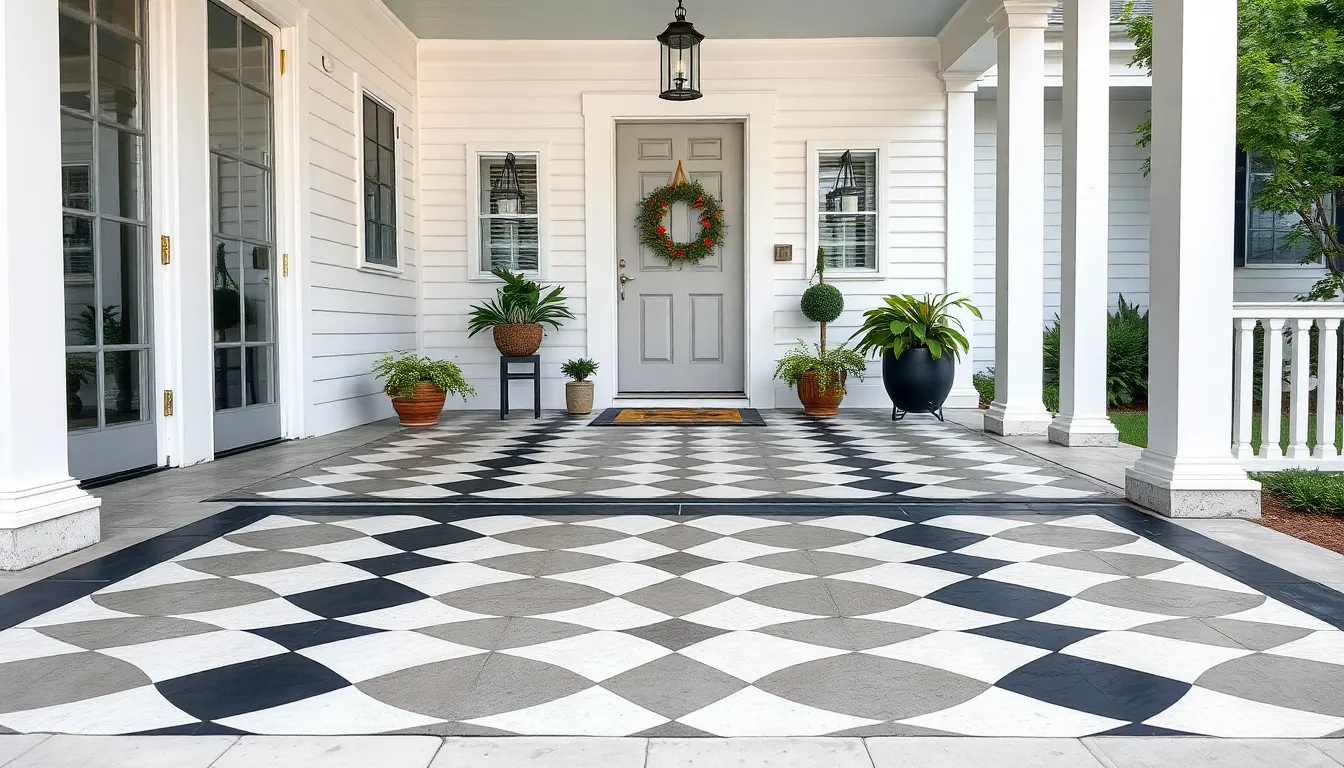
Creating patterns and textures transforms your concrete porch from ordinary to extraordinary while adding personality that complements your home’s architectural style. We’ll explore three proven techniques that deliver professional results with manageable DIY execution.
Geometric Stencil Designs
Geometric stencil patterns create sophisticated visual interest that elevates your porch’s overall appearance. We recommend starting with tile stencils to create star shapes or other angular designs that add custom appeal without overwhelming your space.
Positioning your stencils consistently across the surface ensures a polished look that appears intentionally designed rather than randomly placed. Black and white combinations work exceptionally well for geometric patterns since they provide strong contrast while remaining versatile enough to complement various home exteriors.
Application becomes easier when you:
- Secure stencils with painter’s tape to prevent shifting
- Use foam rollers for even paint distribution
- Remove stencils while paint remains slightly wet to avoid peeling
Checkerboard Patterns
Checkerboard designs offer timeless elegance through their simple yet impactful visual structure. We suggest using subtle neutral tones like varying gray shades rather than stark contrasts to create sophistication without overwhelming your outdoor space.
Planning your checkerboard requires these key measurements:
- Mark equal squares across your porch surface
- Use chalk lines to ensure straight, even rows
- Test your color combination on a small area first
Creating neat, orderly aesthetics becomes achievable when you tape off alternating squares and paint them systematically. This classic pattern works particularly well for front patios where you want to make a welcoming first impression while maintaining visual harmony with your home’s exterior.
Faux Stone Texture Effects
Faux stone techniques deliver the rustic charm of natural stone without the associated cost or installation complexity. We achieve realistic stone appearances by using contrasting colors and specialized application methods like sponging or stippling that create depth and visual texture.
Building authentic stone textures involves:
- Applying a base coat in your lighter stone color
- Dabbing darker tones with natural sponges for variation
- Blending colors while wet to avoid harsh lines
Mimicking natural stone patterns requires observing real stone surfaces and replicating their irregular color variations and surface textures. Using quality concrete paints designed for porches ensures your faux stone finish withstands weather exposure while maintaining its realistic appearance over time.
Add Decorative Borders and Trim Details
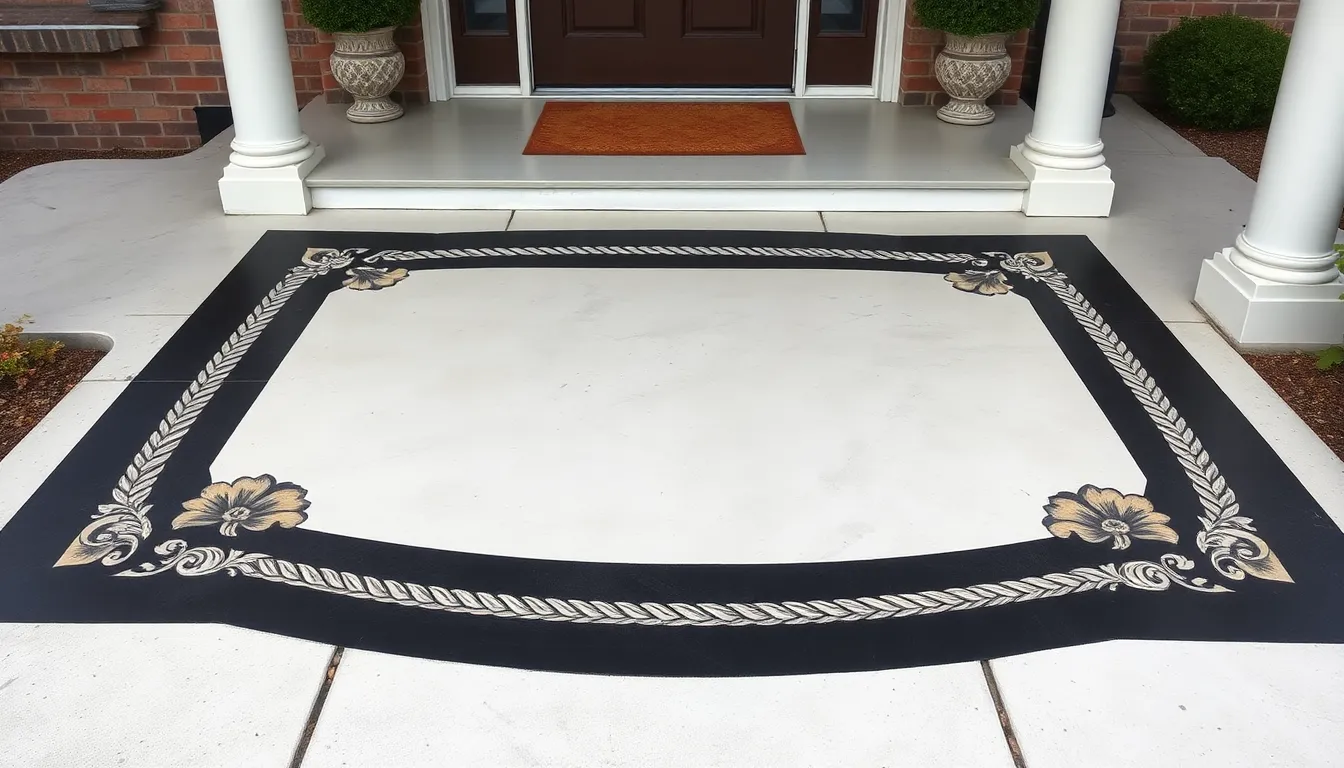
Elevating your concrete porch from ordinary to extraordinary often comes down to the finishing touches. We’ll show you three proven techniques that transform basic painted surfaces into sophisticated outdoor spaces.
Contrasting Color Borders
Contrasting color borders create a striking frame effect that enhances your porch’s overall design impact. We recommend applying a darker trim border around a white base porch to add visual interest and clearly define the space. This technique works by carefully cutting in around the edges with a small brush before rolling the main surface.
Starting with your lighter base color allows you to achieve clean, professional looking lines. We suggest using porch and patio floor enamel paint like Sherwin Williams “Snowbound” for durability and weather resistance. Dark borders make light colored porches pop visually while providing a polished, finished appearance that complements your home’s architecture.
Rope Pattern Edging
Rope pattern edging adds texture and classic decorative appeal to your porch perimeter. We can achieve this elegant look using stencils or freehand painting techniques with contrasting colors. This method gives your porch a handcrafted appearance that elevates the entire outdoor space.
Creating rope patterns requires steady hands and patience, but the results deliver sophisticated visual impact. We recommend practicing the pattern on cardboard first to perfect your technique. Bold rope edging works particularly well with traditional and coastal home styles, adding nautical charm that draws attention to your porch’s defined boundaries.
Medallion Corner Accents
Medallion corner accents serve as sophisticated focal points that draw the eye and complement your overall porch design. We paint these decorative elements within the border areas to add detail and visual sophistication. Floral medallions work especially well for creating elegant touches that enhance your porch’s character.
These accent pieces require more detailed work but deliver important aesthetic impact. We position medallions strategically at corners or midpoints along longer borders to create balanced visual interest. High gloss paint finishes make these details shine and highlight the decorative elements effectively, ensuring they stand out against the main porch surface.
Incorporate Nature-Inspired Color Schemes
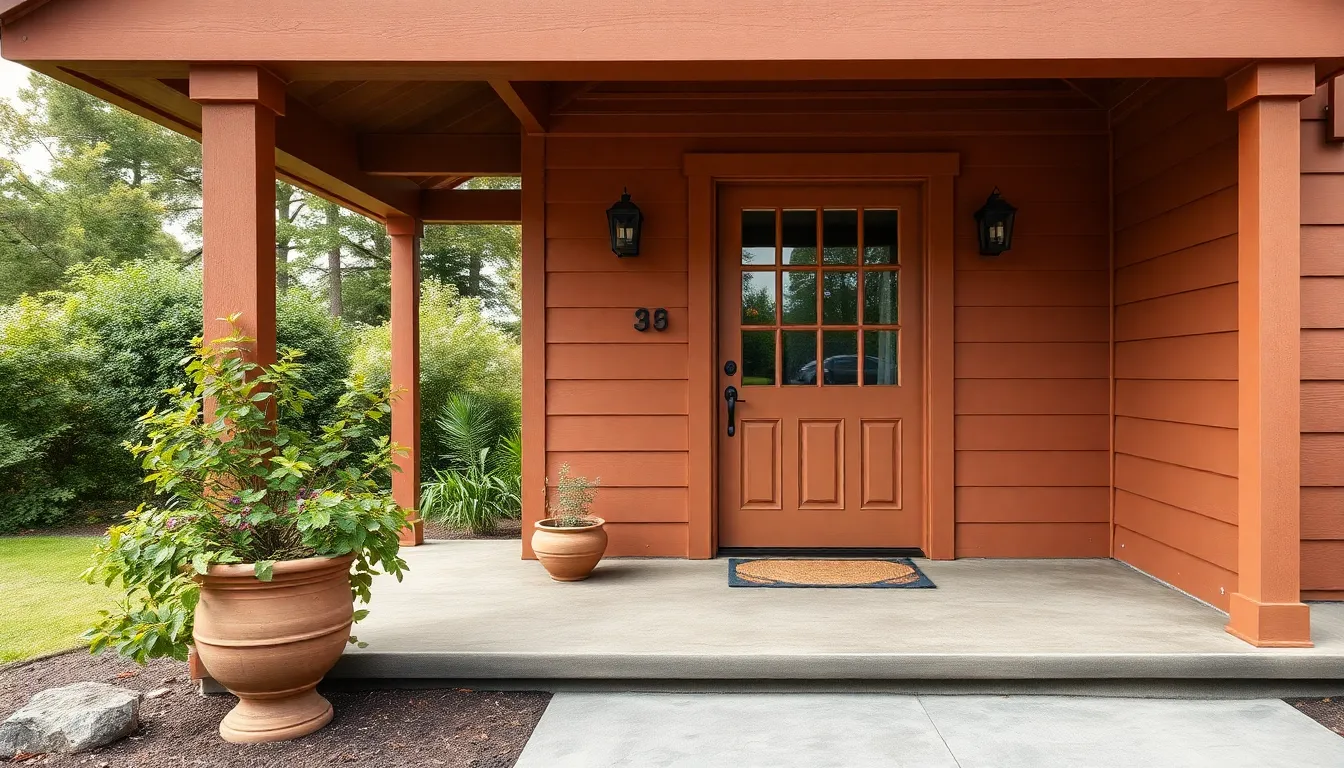
Transforming your concrete porch with nature-inspired palettes creates a seamless connection between your home and the surrounding environment. These organic color combinations bring warmth and visual harmony to outdoor spaces while maintaining sophisticated curb appeal.
Earth Tone Combinations
Earth tones offer timeless versatility for concrete porch painting projects. We recommend selecting combinations that reflect natural landscapes to create a grounding effect for your outdoor space. These organic palettes work beautifully with various architectural styles while providing a sophisticated foundation for seasonal decorations.
Popular earth tone pairings include warm terracotta with olive undertones, rich brown with creamy stone accents, and weathered bronze with sage green highlights. Each combination draws inspiration from natural elements like desert landscapes, forest floors, and rocky coastlines.
Mediterranean and rustic home styles particularly benefit from these warm earth tone selections. The organic appeal of these combinations enhances garden greenery and stone features while creating an inviting atmosphere for outdoor entertaining.
Coastal Blue and Sandy Beige
Coastal blue paired with sandy beige creates a serene seaside ambiance on your concrete porch. Powder blue and soft blue shades work particularly well with warm sandy beige tones to evoke peaceful beach landscapes. This combination transforms ordinary concrete surfaces into relaxing outdoor retreats.
Light blue porch ceilings add an airy feel while drawing the eye upward, creating visual height and openness. We often complement this coastal palette with crisp white trim to enhance brightness and create clean architectural lines.
Consider using the coastal blue as your primary porch color with sandy beige accents along borders or decorative elements. This approach maintains the calming effect while adding visual interest through strategic color placement.
Forest Green and Stone Gray
Forest green combined with stone gray reflects sophisticated woodland aesthetics perfect for nature-loving homeowners. Deep forest green provides richness and depth while natural stone gray adds modern elegance to concrete surfaces. This palette works exceptionally well with garden greenery and existing stone architectural features.
Gray ranges from light silvery tones to dramatic charcoal can create varying effects depending on your home’s exterior style. We recommend pairing deeper forest greens with lighter stone grays for maximum contrast and visual impact.
This combination integrates beautifully with natural landscaping while offering year-round appeal that doesn’t compete with changing seasonal colors. The sophisticated woodland aesthetic creates a grounding environment that feels both contemporary and timeless.
Apply Specialty Finish Techniques

Beyond solid colors and patterns, we can elevate our concrete porch with specialty finish techniques that add dimension and character. These methods transform flat surfaces into visually rich focal points that capture attention and enhance curb appeal.
Color Washing for Depth
Color washing creates stunning visual depth by applying a translucent layer of paint or tinted glaze over our base coat. We use this technique to achieve a soft, weathered appearance that’s perfect for Mediterranean-inspired or aged looks on concrete surfaces.
The process involves using a large brush or rag to gently apply the translucent layer, then wiping off excess for a natural finish. This method subtly blends colors together, resulting in organic variations that add sophistication to our porch design. We can pull colors from surrounding architecture to ensure cohesion with our home’s existing palette.
Color washing works exceptionally well when we want to create an aged patina effect without the expense of natural stone or extensive weathering. The technique allows us to build up multiple layers of color, creating complexity that catches light differently throughout the day.
Dry Brushing for Aged Appearance
Dry brushing delivers authentic aged charm by creating streaks and highlights that mimic natural wear patterns. We achieve this effect by dipping a dry brush lightly into paint and removing most of it before applying to the surface.
This technique creates irregular streaks that enhance texture and give our concrete porch a rustic, vintage appearance. The method works particularly well for farmhouse styles or when we want to emulate natural weathering without extensive distressing.
We can control the intensity of the aged effect by adjusting how much paint remains on our brush. Light applications create subtle highlights, while slightly heavier applications produce more pronounced streaking. The key is maintaining a light touch to avoid overwhelming the base color.
Sponge Painting for Subtle Texture
Sponge painting adds organic texture patterns that simulate natural materials like stone or stucco. We use either a natural sea sponge or synthetic sponge dipped lightly in paint and dabbed onto the surface for irregular, appealing patterns.
This technique softens harsh lines and adds warmth to our concrete porch floor while creating visual interest through texture variation. The dabbing motion creates random patterns that avoid the uniformity of solid paint applications.
Natural sea sponges produce the most authentic texture effects, though synthetic sponges offer more control over pattern consistency. We can layer different colors using the sponge technique to build depth and create more complex surface appearances. The method works best when we use exterior-grade acrylic latex paint with good weather resistance for durability.
Maintain Your Painted Concrete Porch
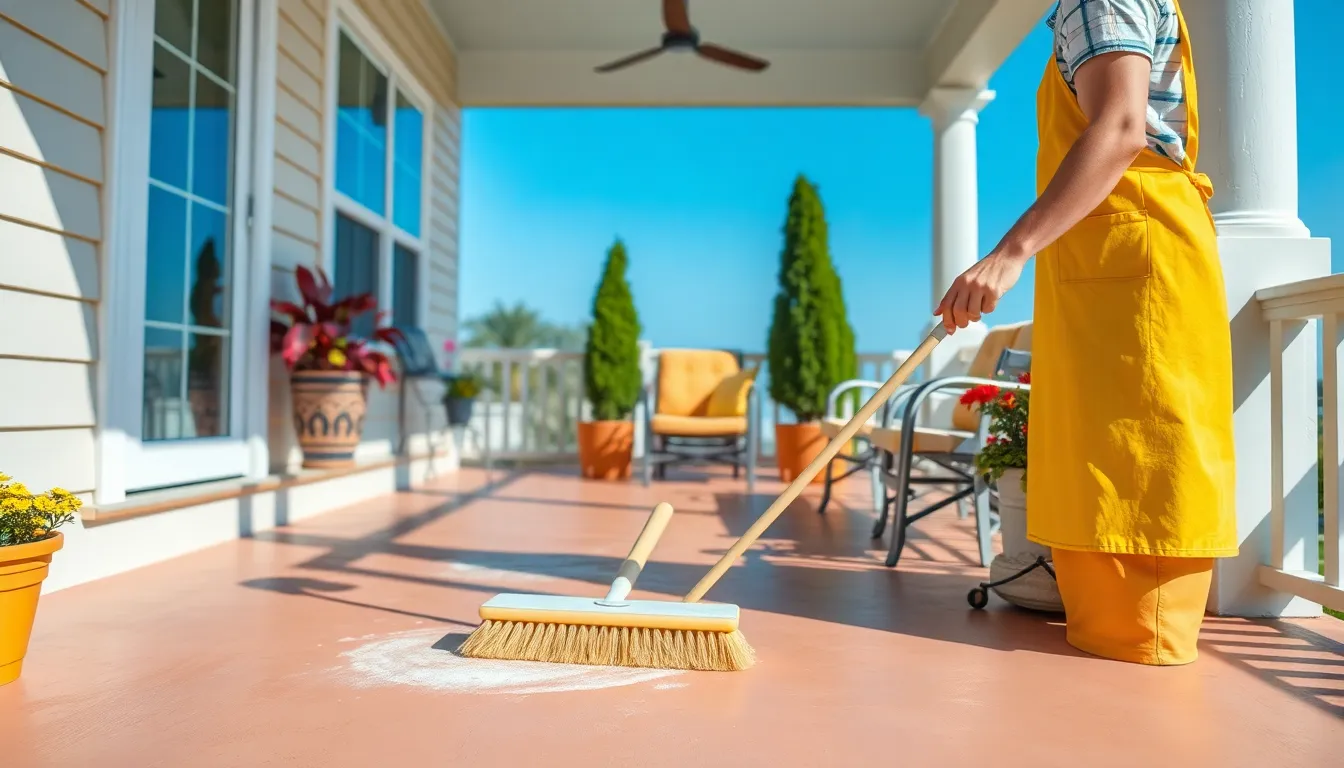
Keeping your painted concrete porch looking fresh requires consistent maintenance and attention to detail. We’ll guide you through the essential maintenance steps that protect your investment and preserve your porch’s beautiful appearance.
Regular Cleaning Schedule
Sweeping your painted concrete porch weekly prevents dirt and debris from accumulating on the surface. Wash the entire area monthly using mild detergent mixed with water, focusing on high traffic zones where foot traffic creates more wear patterns. Pressure washing works effectively for deeper cleaning sessions, but we recommend using low pressure settings to avoid damaging the paint layer.
Remove stains immediately when they occur, as organic materials like leaves and food spills can penetrate the paint if left untreated. Scrub stubborn spots gently with a soft bristled brush and appropriate cleaning solution to prevent permanent discoloration. Schedule thorough deep cleaning sessions quarterly, especially before seasonal weather changes that might stress the painted surface.
Touch-Up Paint Applications
Inspect your painted porch monthly for chips, cracks, or worn areas that compromise the protective coating. High traffic zones near doorways and seating areas typically show wear first and require more frequent attention. Apply touch up paint immediately to small damaged spots using a brush that matches the original application tool.
Clean the damaged area thoroughly before applying new paint, removing any loose paint chips or debris that could affect adhesion. Match the existing paint color carefully, as weathering can slightly alter the original shade over time. Allow proper drying time between coats, typically 24 hours, to ensure the touch up paint bonds correctly with the existing surface.
Protective Sealant Reapplication
Apply protective sealant every 1-2 years to maintain your concrete porch paint’s durability and color retention. Weather conditions in your area determine the exact reapplication schedule, with harsh climates requiring more frequent treatment. Choose high quality products like DRYLOK® Concrete Paint and compatible sealants for optimal longevity and protection.
Clean the surface completely before sealant application, ensuring no dirt or residue interferes with proper bonding. Apply the protective coating evenly using a roller or brush, following manufacturer specifications for coverage rates and drying times. Monitor the sealed surface for signs of wear, such as water absorption or fading colors, which indicate the need for earlier reapplication than originally scheduled.
Conclusion
We’ve walked you through every aspect of transforming your concrete porch from ordinary to extraordinary. With the right paint selection proper preparation techniques and creative design approaches you’re now equipped to tackle this rewarding home improvement project.
Remember that patience during the preparation phase and attention to detail during application will determine your project’s success. Whether you’ve chosen a classic solid color or decided to experiment with patterns and textures the key lies in following each step methodically.
Your newly painted concrete porch won’t just enhance your home’s curb appeal—it’ll become a welcoming space that reflects your personal style. With proper maintenance these results will continue to impress visitors and provide lasting value to your property for years to come.
Frequently Asked Questions
What type of paint is best for concrete porches?
Acrylic latex paint is the most popular choice for concrete porches due to its durability, weather resistance, and easy application. It typically lasts 7-10 years with proper care. For high-traffic areas, epoxy paint offers superior durability and chemical resistance, while concrete stain provides a natural look by penetrating the surface and enhancing texture.
How do I prepare my concrete porch for painting?
Proper preparation involves three key steps: thorough cleaning with pressure washing or concrete cleaner to remove dirt and grease, repairing any cracks or imperfections with appropriate filler materials, and applying a specialized concrete primer to enhance paint adhesion. This preparation ensures better paint longevity and professional-looking results.
What are the most popular colors for concrete porches?
The top three classic colors are neutral gray for timeless versatility, crisp white for clean elegance that brightens spaces, and bold navy for modern sophistication. These colors enhance architectural details, pair well with various home styles, and provide excellent curb appeal while maintaining their visual impact over time.
Can I create patterns on my concrete porch?
Yes, you can create stunning patterns using geometric stencils for sophisticated designs, checkerboard patterns for timeless elegance, or faux stone texture effects for rustic charm. These techniques add personality and visual interest to your porch while maintaining a professional appearance when executed properly.
How can I add decorative finishing touches to my painted porch?
Consider adding contrasting color borders for a striking frame effect, rope pattern edging for classic texture appeal, or medallion corner accents as sophisticated focal points. These decorative elements elevate the overall design and create a polished, visually appealing outdoor space that complements your home’s architecture.
What are some nature-inspired color schemes for concrete porches?
Popular nature-inspired combinations include warm terracotta with olive undertones for an earthy feel, coastal blue and sandy beige for serene beach vibes, and forest green with stone gray for woodland aesthetics. These color schemes create seamless connections between your home and natural surroundings.
How often should I maintain my painted concrete porch?
Maintain your porch with weekly sweeping, monthly washing with mild detergent, and quarterly deep cleaning. Address stains immediately and inspect for wear regularly. Apply touch-up paint as needed and reapply protective sealant every 1-2 years to preserve the appearance and protect your investment.
What specialty techniques can add texture to my concrete porch?
Three effective specialty techniques include color washing for visual depth and weathered appearance, dry brushing to mimic natural wear patterns, and sponge painting for organic texture that simulates natural materials. These methods add dimension and character while creating visually rich focal points.

